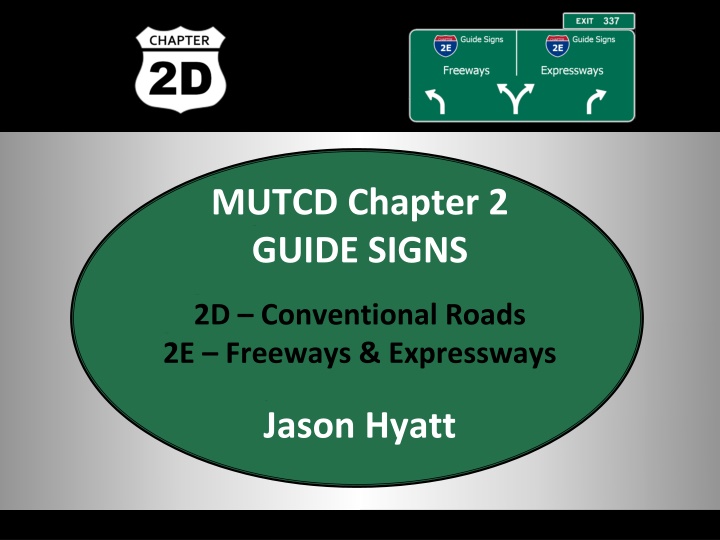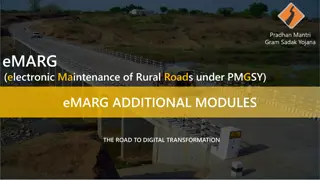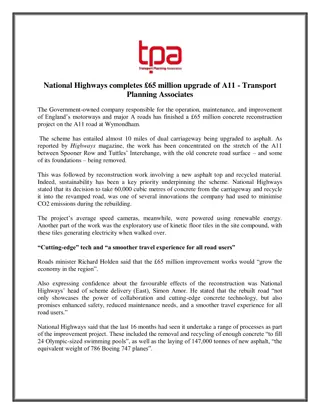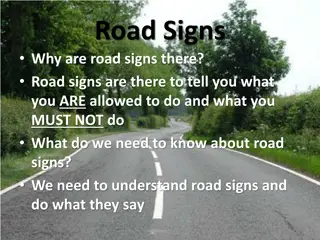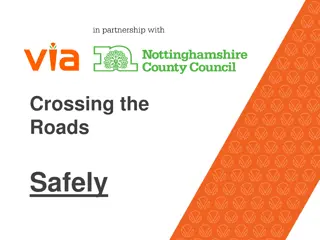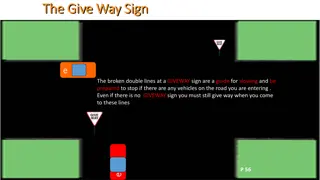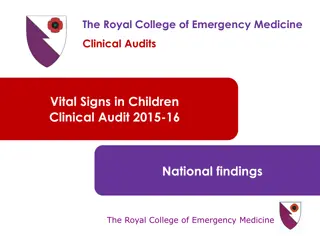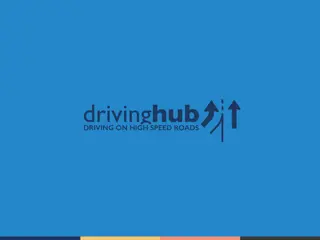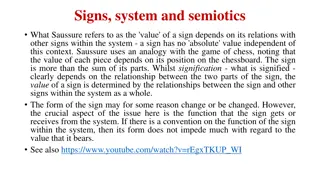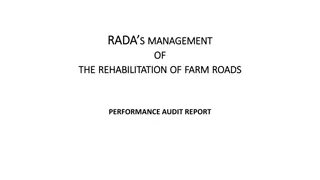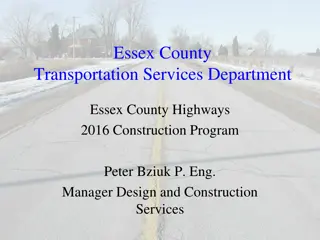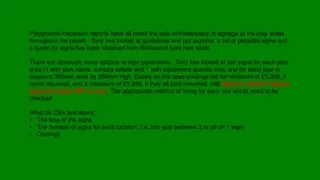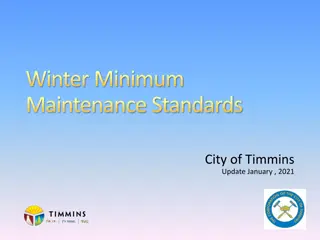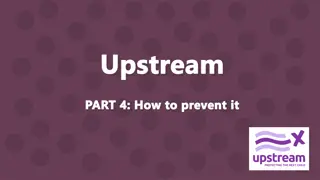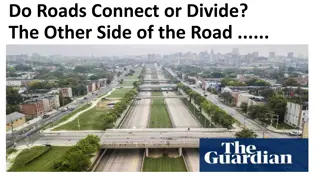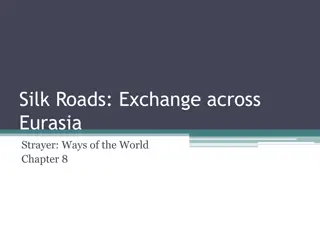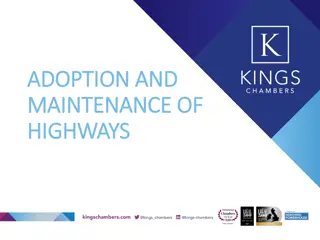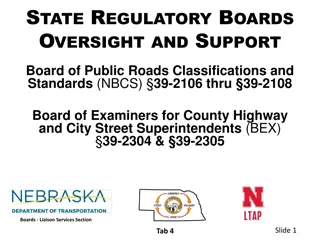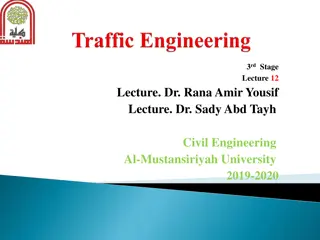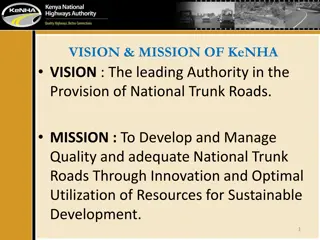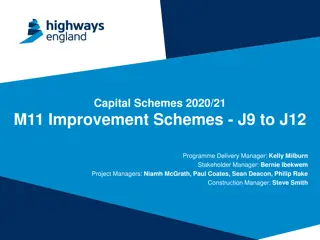MUTCD Chapter 2 Guide Signs for Roads and Highways
Explore the guidelines for guide signs on conventional roads, freeways, and expressways as outlined in MUTCD Chapter 2. Learn about sign sizes, lettering styles, amount of legend information, use of arrows, and new information on directional signage. Follow the regulations for creating effective and standardized road signs to enhance safety and navigation for drivers.
Download Presentation

Please find below an Image/Link to download the presentation.
The content on the website is provided AS IS for your information and personal use only. It may not be sold, licensed, or shared on other websites without obtaining consent from the author.If you encounter any issues during the download, it is possible that the publisher has removed the file from their server.
You are allowed to download the files provided on this website for personal or commercial use, subject to the condition that they are used lawfully. All files are the property of their respective owners.
The content on the website is provided AS IS for your information and personal use only. It may not be sold, licensed, or shared on other websites without obtaining consent from the author.
E N D
Presentation Transcript
MUTCD Chapter 2 GUIDE SIGNS 2D Conventional Roads 2E Freeways & Expressways Jason Hyatt
GUIDE SIGNS CONVENTIONAL ROADS CHAPTER 2D 2D
2D.04 Size of Signs Guide signs that have standardized designs shall have sizes as shown in Table 2D-1
2D.05 Lettering Style Can no longer use all upper-case letters for names of places, streets, and highways. Must be combination of lower-case letters with initial upper-case letter. FRANKLIN DR Franklin Dr
2D.07 Amount of Legend Guide signs should be limited to 3 lines of destinations, which include: Place names Route numbers Street names Cardinal directions
2D.07 Amount of Legend Guide signs should be limited to 3 lines of destinations, which include : Place names Route numbers Street names Cardinal directions A distance message or action info can be provided in addition to the destinations Exit # Next Right Directional arrows
2D.07 Amount of Legend Guide signs should be limited to 3 lines of destinations, which include : Place names Route numbers Street names Cardinal directions A distance message or action info can be provided in addition to the destinations Exit # Next Right Directional arrows
2D.08 Arrows Arrows shall be positioned approximately over the center of the lane and point vertically downward. If this cannot be achieved, then don t use arrows.
2D.08 Arrows New information regarding use of curved-stem arrows for circular intersections. Guidance on other variations of arrows.
2D.08 Arrows On post-mounted signs the directional arrow may be placed below the legend if placing it to the side creates an unusually wide sign. Alexandria Alexandria
2D.27 Lane Designation Auxiliary Signs New Section. A lane designation auxiliary sign can be mounted below an advance route sign. Can only be used for mandatory movement.
2D.33 Combination Lane-Use/Destination Overhead Guide Sign New Section. This sign can only be used for mandatory lane movements. Shall not be used for lanes with optional movements Shall be green with destination on top and lane-use at bottom
2D.37 Destination Signs Horizontal lines separating destinations with different directions NEW OLD
2D.38 Destination Signs at Circular Intersections New Section. Provides Standards, Guidance, and Options regarding destination signs at circular intersections. Shall not depict the number of lanes within, approaching, or exiting the roundabout.
2D.38 Destination Signs at Circular Intersections
2D.43 Street Name Signs Option to incorporate a route shield with the street name
2D.43 Street Name Signs New table with recommended letter heights
2D.43 Street Name Signs Alternate background colors can be used if it is deemed necessary to assist drivers in determining jurisdictional authority for roads Alternative background colors shall not be used for Advance Street Name signs The only acceptable alternate colors are: BLUE BROWN WHITE If used, the alternative background color should be used on all Street Name signs under the jurisdiction of a particular highway agency
2D.45 Signing on Conventional Roads on Approaches to Interchanges This section was previously located in Chapter 2E
2D.45 Signing on Conventional Roads on Approaches to Interchanges On multi-lane conventional roads approaching an interchange, guide signs shall be provided to indicate direction of turn and lane to use for ramp access to each direction on the freeway or expressway
2D.45 Signing on Conventional Roads on Approaches to Interchanges Action message suggestions on Advance Entrance Direction signs changed: LEFT LANE KEEP LEFT
2D.45 Signing on Conventional Roads on Approaches to Interchanges New diagrammatic sign that can be used to depict the location of an entrance ramp that is in close proximity to an intervening intersection where signing only for the ramp might cause confusion
2D.45 Signing on Conventional Roads on Approaches to Interchanges
2D.50 Community Wayfinding Signs New Section Signs with a common color or ID scheme that lead tourists to civic, cultural, visitor, and recreational destinations within a city These signs shall be limited to conventional roads Can have an information sign entering the city identifying the color codes of multiple routes Cannot use standard red, orange, yellow, purple, or the fluorescent versions thereof, fluorescent yellow-green, or fluorescent pink to avoid confusion with higher-priority regulatory and warning signs
2D.50 Community Wayfinding Signs
2D.50 Community Wayfinding Signs
2D.50 Community Wayfinding Signs
2D.50 Community Wayfinding Signs Not for primary destinations Incorrect arrow placement and order of destinations Incorrect use of boundary sign (excessive info)
2D.50 Community Wayfinding Signs BONUS: No lines separating destinations by direction direction BONUS: No lines separating destinations by
2D.50 Community Wayfinding Signs
337 Guide Signs Guide Signs CHAPTER 2E CHAPTER 2E Freeways Expressways
2E.10 Amount of Legend on Guide Signs No more than 2 destinations on one sign Avoid a city name and street name on same sign Sign legends should not exceed three lines of copy, exclusive of the exit number and action or distance info
2E.14 Size and Style of Letters and Signs Standardized freeway and expressway guide signs shall have sizes as shown in Table 2E-1 Option: Larger signs may be used
2E.17 Abbreviations Words like: Street Boulevard Avenue should be abbreviated to expedite recognition of the sign legend
2E.17 Abbreviations Use a hyphen instead of a solidus (slanted line), which should only be used for fractions CARS/TRUCKS CARS TRUCKS
2E.18 Symbols Symbol designs shall be unmistakably (previously essentially ) like those shown in this Manual and in the Standard Highway Signs and Markings book
2E.19 Arrows for Interchange Guide Signs On post-mounted signs the directional arrow may be placed below the legend if placing it to the side creates an unusually wide sign. Alexandria Alexandria
2E.19 Arrows for Interchange Guide Signs Arrows shall be placed over the center of the lane to which it applies Down arrows shall only be used for lanes restricted to one direction of travel Cannot have multiple down arrows pointing to the same lane
2E.19 Arrows for Interchange Guide Signs Avoid ambiguous placement of down arrow ?
2E.20 Signing for Option Lanes at Splits and Multi-Lane Exits New Section Introduces the Arrow-per-Lane guide sign design Arrow-per-Lane or Diagrammatic guide signs shall be used for all multi-lane exits at major interchanges with an option lane Arrow-per-Lane and Diagrammatic guide signs shall not be used on freeways and expressways for any other type of exits or splits that do not have an option lane Arrow-per-Lane should be considered for intermediate interchanges. Conventional guide signing can be used at minor interchanges if Arrow-per-Lane is not warranted
2E.21 Arrow-per-Lane Guide Signs
2E.22 Diagrammatic Guide Signs Diagrammatic guide signs have been shown to be less effective than conventional or overhead Arrow-per-Lane guide signs at conveying the destination/direction that each lane serves, regardless of whether dedicated or option lanes are present
2E.21 Arrow-per-Lane Guide Signs Arrow-per-Lane guide signs shall be used on all new or reconstructed freeways and expressways
2E.21 Arrow-per-Lane Guide Signs APL sign at the exit shall be located where the lanes begin to diverge from one another NOT at the theoretical gore Not here! Here!
2E.21 Arrow-per-Lane Guide Signs Option: At existing, non-reconstructed locations, an existing structure at the theoretical gore can be used with Exit Direction and Pull Through signs in conjunction with APL advance signs
2E.21 Arrow-per-Lane Guide Signs
2E.21 Arrow-per-Lane Guide Signs Option: At existing, non-reconstructed locations, an existing structure at the theoretical gore can be used with Exit Direction and Pull Through signs in conjunction with APL advance signs Cannot use APL at the gore in this situation
2E.21 Arrow-per-Lane Guide Signs
2E.21 Arrow-per-Lane Guide Signs Option: At existing, non-reconstructed locations, an existing structure at the theoretical gore can be used with Exit Direction and Pull Through signs in conjunction with APL advance signs Cannot use APL at the gore in this situation If being reconstructed, cannot use Exit Direction sign at the gore must use standard APL signing sequence
2E.23 Intermediate and Minor Interchanges with Option Lane For non-major multi-lane interchanges with an option lane, it may be suitable to use post-mounted guide signs.
